Reviews
Review: Shadows of the Damned
July 21, 2011, Author: Andy Corrigan
I have a confession to make that may surprise, upset, or even anger some of my peers. I’d never played a game by Suda 51 before. I know, I know, and it’s not that I didn’t want to. I was desperate to sample the evidently stylish Killer 7, I just never managed to pick up a copy, and although I wouldn’t say I was busting a gut to play No More Heroes, I kinda had my eye on it as one to sample at some stage.
Thankfully, I have been able to rectify this situation with the recently released Shadows of the Damned; a dark and twisted collaboration between Suda 51 and Resident Evil 4 director, Shinji Mikami. I would say that I had no words for the sheer depravity that I witnessed during my time with the game, but then that wouldn’t make for a very interesting review, would it?*
*Probably neither will the actual review, but screw you guys, I do this for free…
Road to hell…
Garcia Hotspur is not just a man with a silly name. He also happens to be one of the world’s most renowned demon hunters, a tattooed baddass and likes to fill his spare time by wearing garish purple clothing. Following a typical night’s work of demon hunting, Hotspur finds himself towering over his latest adversary. The weakened creature, ready to kiss his afterlife goodbye, gives Garcia the word that the underworld has had enough of his meddling and for payback, his much-loved girlfriend, Paula, is in serious trouble.
He hurries home in time to hear her desperate screams coming from the bedroom. After dispatching several foes and hearing her sickening screams brutally cut-short, he finds that his precious sweetheart has been hung from the ceiling. All is not lost, though. After taking care of some more enemies, the six-eyed leader of Hell, Fleming, arrives to claim his prize. While pulling the now-screaming female corpse into his trench-coat, he tells Garcia of his plans to keep torturing Paula over and over for eternity for all the damage he has done to demon-kind. He offers Hotspur a deal; follow him to Hell and he’ll release the woman. An offer that Garcia can’t refuse.
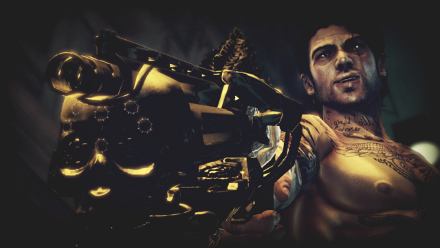
Garcia Hotspur: Top bloke, crap name.
I’ve almost managed to paint a picture of a semi-serious storyline there, but that couldn’t be further from the truth. This is a game that enjoys its own pure silliness in a way I haven’t seen since Bayonetta completely enraptured me two years ago. This game, however, is far more twisted on so many levels and only really on par with the works of director Sam Raimi circa 1981. As such, it’s drawn so many comparisons to the Evil Dead series and at the expense of being original, I have to say that those comparisons are entirely accurate. There’s even an entire level dedicated to taking a cheeky nod to the events of Evil Dead 2 and while I won’t go into the exact details, fans of Raimi’s work will love these moments. Evil Dead isn’t the only film that’s paid homage in this game, but Suda 51’s inspiration for Shadows of the Damned is pretty clear.
There are also a lot of odd, and sometimes dark, sexual references that are threaded into everything you do. There are obvious things such things as the naming conventions of the weapons, with the Hot Boner pistol being the obvious one to point out, which shoots ‘an explosive, sticky payload’ as its secondary fire. Garcia’s visions of Paula in lingerie haunting him around his adventures in the City of the Damned is another prominent theme, along with other elements of pure wrongness that are purely there to make you feel uncomfortable, make you laugh, or both depending on your mindset.
There are also a lot of subplots told via the relationship between Garcia and his all-purpose, transforming spirit guide, Johnson, (who actually serves as all your weaponry in this adventure; more on that later). You’ll discover facts about the more monotonous aspects of the lives of demons; their laws, their politics, how they relax and their interactions with the real world. It’s an odd thing to imagine a demon knocking off work to go to their local for a pint, or voting democratically to nominate a leader, but that’s something you’ll come to do over the course of this game.
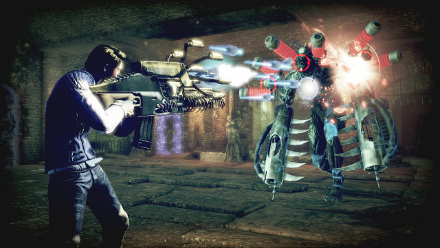
Not even the start of the twisted stuff you’ll see…
You’ll also learn of the utterly bizarre circumstances on how Garcia and Paula got together, and how fiery their relationship could be, and these stories are often hilarious. Occasionally you’ll find demon storybooks to read, with fables and sick little tales told within, and these are narrated by Johnson or Hotspur himself, who has the reading ability of a pre-schooler. These provide moments of calm, where you can relax and readjust your nerves before moving on, but also can give you the back-story on upcoming bosses.
Grab yer Johnson!
It’s when you get to actually play the game that you start to feel the influence of legendary developer Mikami. Just like Resident Evil 4 (and to a lesser degree in more recent years, Resident Evil 5 and Dead Space), Shadows of the Damned is an over-the-shoulder shooter, where the laser-sight plays a significant part in lining up your shots. The controls here are solidly implemented and feel smooth with satisfying feedback, though the camera control on the right stick can move a little wildly at times.
Only about half of the game is actually about the combat (though it is a large part), the rest is about navigating your way through the areas by solving puzzles to continue your progress. For the early part, most of these puzzles see you using light to your advantage. You see, a lot of the areas are filled with a substance described as pure darkness, or at least they will be at some stage after entering them. Once in an area shrouded in this sickly darkness (which is actually a blue colour…), your health will constantly deplete until you get out of it, and this changes dynamics in a couple of ways. For a start, you’ll have to look for a light source to clear the darkness, and these, oddly, come in the form of wall-mounted goats heads. To illuminate the immediate area, you have to find the designated goat’s head and hit it with a ‘light shot’, which is the standard secondary fire for all three of your guns.
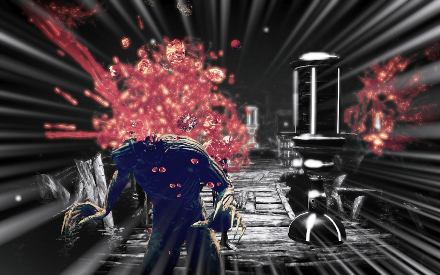
You get this awesome effect whenever you bag a perfect headshot!
Usually, I’d roll my eyes at this sort of system as they often quickly lead to frustration or plate-spinning scenarios, but in Shadows of the Damned it compliments the way the puzzles are woven into the gameplay. That’s not to say that the game gets overly repetitive or relies too heavily on this system either. It’s a certain theme throughout, granted, but there are a myriad of puzzle types with original devices being drip-fed throughout. I won’t go into greater detail through fear of spoiling them, as their impact relies on the unexpected. It’s a game that knows its own boundaries too, knowing the right time to offer a change in pace, usually in the form of some unexpected side-scrolling shooting or some zombie bowling.
Any enemies that enter or are touched by pools of darkness will be coated in it, even when you turn the lights on. These guys can’t be killed with your standard weapons initially, and instead have to be hit with a light shot first to clear them of their protective sheath. It’s a bit like Alan Wake, but instead of having to drain your enemies, it’s one shot, then you can carry on maiming. If you hit a standard demon with your light shot, you’ll temporarily freeze them, allowing you to get in close to do one of the game’s brutal mêlée attacks. Thankfully, if the enemies do get the better of you, checkpoints are pretty generous in their regularity, managed by a timid character called One-Eyed Willy who darts off when approached, leaving a steaming turd to indicate a save point.
It feels wrong to say that the only thing you’ll have to help deal out the damage to the baddies is your Johnson. Johnson is a former inhabitant of the City of the Damned, and is now Garcia’s spirit guide and only source of weaponry. For story purposes, he has an ability to transform into pretty much anything, but in gameplay he’ll only really serve as your firepower. So, when not in combat, he acts as an old-fashioned torch, lighting your way through the dingy pathways. In this form, he’s also your mêlée weapon, able to make quick jabs or a charged rotational attack, Link-stylee. As soon as you hit the left trigger to aim, he transforms into one of three guns that you’ll unlock pretty early on.
The first one you’ll have access to is the Boner, which is your typical handgun and probably the one you’ll use the most, although the others have their uses in specific situations. The other two include the Teether, an SMG style weapon, and the Monocussioner, which is a cross between a shotgun and a grenade launcher. After you beat the various boss fights throughout the game, these guns will automatically evolve and upgrade a number of times throughout, gaining new powers or features.
So, for example, over time the Boner will become the Hot Boner, capable of delivering sticky bombs as its secondary fire, and the Monocussioner eventually allows you to charge up a lobbable time bomb, useful for solving certain puzzles. Switching between these weapons in the midst of combat is nice and easy, thanks to them being mapped to the top three d-pad directions. Each one also turns Johnson a different colour too, so you know exactly what you’re wielding at any time.
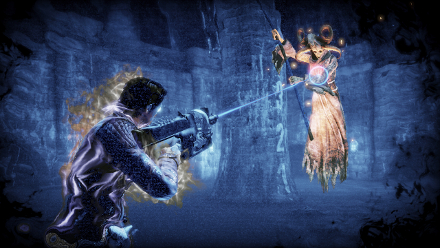
Sometimes the only way to win is to embrace the darkness…
You can upgrade the guns a little further by finding red gems along the way and spending them on attributes such as damage, capacity and reload speed from the start menu. You can also spend the red gems on increasing Garcia’s health or the rate of fire for the light shot. Replenishing your health is done by downing the alcohol that you find or purchase from vending machines, using the white gems that enemies drop as currency. You can also spend these gems with Christopher; a half-human (but all redneck) who will literally take them off your hands in exchange for the consumables featured in the game.
The enemies themselves are widely varied and come thick and fast, though you’ll encounter a mindless zombie type the most. Dispatching all of them is immense fun, with amputating a leg or an arm being almost as fun as bagging the perfect head shot. With each new enemy comes a new way to dispatch of them, and this makes for fun experimentation with the arsenal at your disposal. There was one foe in particular that I was struggling with, only to work out a quick and easy way to kill them towards the end. I found this refreshing, with the game not spoon-feeding me the answers at every turn. There are some more obvious enemies too. You know the type; the big ones with a glowing red core, which, of course, is the only way to cause them harm. Fear not, though, there is enough variety here to keep the combat side of things enjoyable no matter who or what you’re facing.
The most formulaic of the enemies are definitely the bosses, which are probably also the easiest aspects of Shadows of the Damned, and on normal difficulty you’ll only ever really struggle if you don’t spot their individual pattern straight away. For what they lack in complexity, they definitely make up for in imagination, as each one is really an experience to fight, offering deranged sights and plenty of comedy with them. They certainly make for enjoyable endings to given chapters.
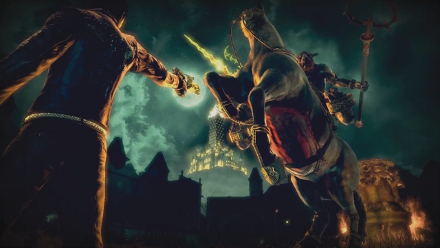
This is one of the craziest bosses.
‘Everybody knows that goats are a source of light’.
Shadows of the Damned is, by all accounts, a decent looking game. However, it’s definitely far from being the best looking game you’ve seen this generation and is unlikely to really wow people in this regard. The graphics are probably the weakest aspect in all fairness, and even then they’re really not bad at all. That really should speak volumes for the quality of the rest of the game.
The main problem you’ll find is that certain textures are hit and miss, either perfectly rendered or blocky as hell. It’s all fine when at a distance, but when you get up close and personal the blocky nature of some of the textures (mainly in the finer details) really stand out. Garcia’s tattoos are a prime example of this and will probably be the one that you’ll notice the most. Then you’ve also got that age-old Unreal Engine issue where it’s prone to occasional texture pop-in, especially just after a loading screen.
Aside from those little issues, the game oozes its enjoyable but purely deranged style from every orifice, and this more than makes up for any technical hiccups. In general play, the enemies and the environments are aptly put together, and although the opening portions of the game paint a picture of a rather samey looking title throughout, the second half really brings home the variety.
I really loved the general presentation of this game too, from the simplistic menu system to the 2D loading screens depicting Hotspur’s progress through the underworld. The visual styling for these load-screens actually comes into gameplay about halfway through the game, but to explain the circumstances would spoil it entirely.
‘It sounds like a cat trying to have sex with a harmonica’.
If the visuals were the worst part of the game, then the audio is easily the best. The voice acting is terrific, with the vocal charms of Greg Ellis and Steve Blum leading the way with their banter as Johnson and Garcia. The rest who contribute to a great cast of characters may be outshone by these two, but their contributions are no less significant.
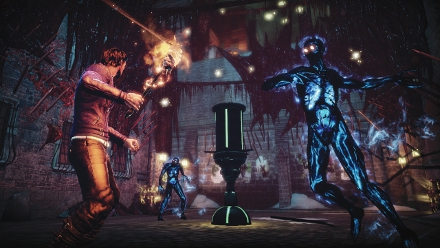
These mofos won’t go down until you hit them with a light shot.
The soundtrack is even better and crafted mostly by Silent Hill composer Akira Yamaoka; a far cry away from his works in that franchise. The chilling and distorted tones compliment both the story and setting brilliantly, and you can tell that this was scored with a lot of love for the material. A lot of it would sit pretty comfortably atop a Tarantino movie, and it’s typical of the B-movie they were trying to create. There’s a lot to love here, and hell, I could just sit and listen to the music from the loading screen for hours, with the dirty blues riff forever imprinted in my brain.
For an extra aural treat, make sure you stick around after the credits…
‘Glory, glory, Garcia Hotspur…’
Whether you see Shadows of the Damned as a highly playable, solid and stylish nod to the humble B-movie or as an average shooter with an impenetrable plot is going to depend greatly on personal tastes. It sounds like a cop-out to end an otherwise objective review with that sentiment, but if you don’t get that this is the gaming equivalent of an old grindhouse film; a purposely trashy B-movie that asks you to merry yourself in the ridiculousness of it all as much as it loves dishing it out, then you’ll find that a lot of the best things the game has to offer will pass you by completely.
For me? Having grown up on Raimi’s unique brand of awesomeness, Tarantino’s style and other cheesy horrors, Shadows of the Damned is simply a must buy title. It lets you live the experience of being in a low-budget movie, with all the hammy presentation, witty dialogue, and disturbed undertones present and correct. Throw in memorable characters, solid gameplay mechanics and easily the soundtrack highlight of the year thus far, and you have a combination that is not often nailed all too well in the games industry. In a sea of bland games that take themselves too seriously, it stands out amongst the dross in the same way that Bayonetta did last year. I just can’t promise it’ll resonate with everyone in quite the same way.
Platforms: PS3, Xbox 360 | Tagged demons, EA, Electronic Arts, Fleming, Garcia, Garcia Hotspur, Grasshopper Manufacture, guns, Johnson, Paula, Shadows of the Damned, Shooter, Suda 51, Third Person Shooter, Third-Person



